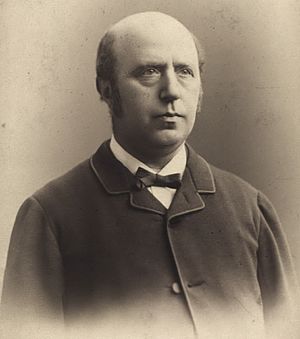Harald Hirschsprung facts for kids
Quick facts for kids
Harald Hirschsprung
|
|
|---|---|
 |
|
| Born | 14 December 1830 |
| Died | 11 April 1916 (aged 85) |
| Citizenship | Denmark |
| Known for | Hirschsprung's disease |
| Medical career | |
| Profession | Doctor |
| Field | Physician |
| Institutions | University of Copenhagen, Queen Louise's Children's Hospital |
Harald Hirschsprung (born December 14, 1830 – died April 11, 1916) was a famous Danish physician (doctor). He is best known for being the first to describe a serious bowel condition. This condition now carries his name: Hirschsprung's disease.
Contents
Harald Hirschsprung's Life and Work
Harald Hirschsprung was born in Copenhagen, the capital of Denmark. His parents were Jewish. Instead of joining his father's tobacco factory, Harald decided to become a doctor. He started university in 1848 and finished his medical studies in 1855.
Becoming a Children's Doctor
Harald Hirschsprung was always interested in rare diseases. Especially those that affected the gut (digestive system). In 1861, he wrote his doctoral thesis about problems with the oesophagus (food pipe) and small bowel (small intestine).
In 1870, he became the first Danish pediatrician. A pediatrician is a doctor who specializes in treating babies and children. He worked at a hospital for neonates (newborn babies). In 1879, he became the chief doctor at Queen Louise's Children's Hospital. This hospital had just opened that year.
Teaching and Helping Others
Harald Hirschsprung became a professor of pediatrics in 1891. He taught small classes on Sunday mornings. He wanted to make sure only truly dedicated students attended. He focused on rare cases, which were interesting but not always helpful for general practice.
Hirschsprung believed in helping everyone. He offered free health care to poor children. He still asked patients who could afford it to pay. He also had a unique idea for the hospital. He wanted pictures of animals above each child's bed. This was instead of religious texts, which the queen preferred.
Later Life
In 1904, Harald Hirschsprung was 74 years old. He had to retire from his medical practice. He continued to study the disease that would later be named after him. He lived out his retirement in his country house in Øresund. He was buried in the Jewish section of Vestre Cemetery in Copenhagen.
Hirschsprung's Disease Explained
Harald Hirschsprung wrote about many different childhood illnesses. These included pyloric stenosis (a stomach problem), intussusception (when the bowel folds into itself), rickets (a bone disease), and rheumatic nodules (small bumps under the skin). However, he is most famous for his work on the disease that now bears his name.
His Discovery
In 1886, Hirschsprung gave an important lecture in Berlin. He talked about a new condition he had observed. He described two babies who had died from severe constipation. Their colon (large intestine) had become very wide (dilated) and thick (hypertrophied). He believed this problem started before the baby was born.
He published more details about this condition two years later. He thought it was a completely new disease.
Understanding the Disease Today
Harald Hirschsprung was the first to describe the condition. However, he thought the swollen part of the bowel was the problem. We now know the opposite is true. The problem is in the lower, distal (farther away) part of the intestine.
This part of the bowel is missing special nerve cells called ganglion cells. Without these cells, the bowel cannot relax properly. This makes it hard for stools (poop) to pass through. This leads to severe constipation and can cause a blockage in the intestine.
See also
 In Spanish: Harald Hirschsprung para niños
In Spanish: Harald Hirschsprung para niños

